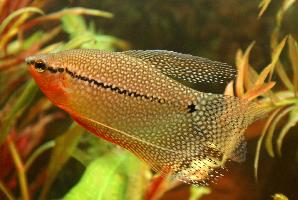
Also known as
- Čichavec obrovský
Weights and measures
| Length | 70 cm |
|---|
Animal description
The Giant Gourami (Osphronemus goramy) is a captivating species of freshwater fish, renowned for its impressive size and intriguing behavior. Native to Southeast Asia, this remarkable creature inhabits slow-moving waters of rivers, lakes, and swamps, thriving in environments rich in vegetation. The adaptability and resilience of the Giant Gourami have allowed it to flourish in a variety of water conditions, making it a prevalent species across its native range and a popular choice among aquarists worldwide.Physically, the Giant Gourami presents a striking appearance. Adults can grow to a formidable size, with specimens reaching up to 70 cm (28 inches) in length and weighing as much as 9 kg (20 lbs), although sizes around 40-45 cm (16-18 inches) are more common in captivity. The body of the Giant Gourami is deep and laterally compressed, with a convex dorsal surface and a nearly flat ventral surface, giving it a somewhat rounded appearance. The fish's scales are large and thick, providing a robust armor against predators and environmental hazards. Its coloration varies significantly depending on age, diet, and habitat, ranging from a silvery hue in younger fish to darker shades of grey, brown, or even golden in mature individuals. Some captive specimens may exhibit more vibrant colors due to selective breeding.
One of the most distinctive features of the Giant Gourami is its labyrinth organ, a unique adaptation that allows it to breathe atmospheric air. This organ is a highly evolved structure located in the fish's head, enabling it to survive in oxygen-depleted waters where other fish species might perish. This ability not only highlights the Giant Gourami's resilience but also its intelligence, as the fish can often be observed surfacing to gulp air.
The diet of the Giant Gourami is omnivorous, encompassing a wide range of food sources. In the wild, it feeds on algae, plants, small invertebrates, and even fish. In captivity, its diet can be easily accommodated with a mix of commercial fish pellets, vegetables, and occasional protein treats like worms or small pieces of meat. This adaptability in feeding habits further underscores the Giant Gourami's versatility as a species.
Socially, the Giant Gourami exhibits a complex range of behaviors. While juveniles may display a degree of sociability, adults tend to become more territorial and may show aggression towards other fish, especially in confined spaces. Males, in particular, can be quite protective of their territory, especially during breeding periods. Breeding behavior is fascinating; males construct bubble nests out of vegetation and debris where females lay their eggs. The male then guards the nest and aerates the eggs until they hatch, showcasing a remarkable level of parental care.
In conclusion, the Giant Gourami is a magnificent creature that embodies the diversity and complexity of aquatic life. Its impressive size, adaptability, and intriguing behaviors make it a subject of fascination not only for scientists and conservationists but also for aquarium enthusiasts around the globe. As a species, the Giant Gourami underscores the importance of freshwater ecosystems and the myriad of life they support, reminding us of the need to protect these vulnerable habitats for future generations.
Similar Animals
New photos of animals
Top 10 animals
- Dolphin gull (Leucophaeus scoresbii)
- Diana monkey (Cercopithecus diana)
- Moustached guenon (Cercopithecus cephus)
- Galápagos tortoise (Geochelone nigra complex)
- Stone loach (Barbatula barbatula)
- Japanese macaque (Macaca fuscata)
- Greek tortoise (Testudo graeca)
- Russian tortoise (Testudo horsfieldii)
- Common flying dragon (Draco volans)
- Galápagos penguin (Spheniscus mendiculus)


